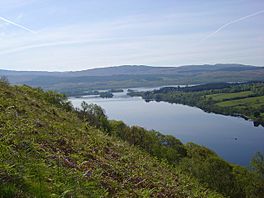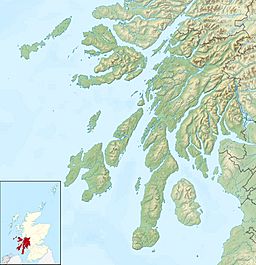Loch Awe facts for kids
Quick facts for kids Loch Awe |
|
|---|---|

Loch Awe, Argyll & Bute
|
|
| Location | Argyll and Bute, Scotland |
| Coordinates | 56°17′52″N 5°14′06″W / 56.29778°N 5.23500°W |
| Type | freshwater loch |
| Primary inflows | River Orchy, Kames River |
| Primary outflows | River Awe |
| Catchment area | 840 km2 (320 sq mi) |
| Basin countries | Scotland |
| Max. length | 41 km (25 mi) |
| Max. width | 1 km (0.62 mi) |
| Surface area | 38.5 km2 (14.9 sq mi) |
| Average depth | 32 m (105 ft) |
| Max. depth | 93.6 m (307 ft) |
| Water volume | 1.2 km3 (0.29 cu mi) |
| Residence time | 0.7 year |
| Shore length1 | 129 km (80 mi) |
| Surface elevation | 36.2 m (119 ft) |
| Islands | Innis Chonnell, Inishail, Innis Chonan |
| Settlements | Lochawe |
| 1 Shore length is not a well-defined measure. | |
Loch Awe (in Scottish Gaelic: Loch Obha) is a very large freshwater loch, or lake, in Argyll and Bute, Scotland. It is found in the beautiful Scottish Highlands. A small village on its banks is also called Lochawe. The loch has several islands, including Innis Chonnell and Inishail.
About Loch Awe
Loch Awe is the third largest freshwater loch in Scotland. It covers an area of about 38.5 square kilometers (14.9 square miles). It is also the longest freshwater loch in Scotland. It stretches for 41 kilometers (25 miles) from one end to the other. Its average width is about 1 kilometer (0.6 miles).
The loch runs from the southwest to the northeast. It flows roughly next to two sea lochs, Loch Etive and Loch Fyne. Water from Loch Awe flows into the River Awe. This river then empties into Loch Etive, which leads to the Atlantic Ocean.
Long ago, a ferry used to cross the narrowest part of the loch. This helped cattle drovers move their animals to markets. In 1955, an important underwater cable, called the Transatlantic Cable, was laid across the loch at this point.
Hydroelectric Power
Loch Awe is home to two important hydroelectric power projects. These projects use the power of water to create electricity.
Inverawe Power Station
One project is the Inverawe power station. It is owned by SSE. This station uses a traditional way to make power. A dam was built on the River Awe. Water flows from the dam through a large underground tunnel. As the water rushes out, it spins a turbine. This turbine then generates electricity. The water then flows back into the River Awe and into Loch Etive.
The power station also has a special "fish pass." This allows salmon to swim upstream into Loch Awe to lay their eggs. Young salmon can safely pass downstream through the power station's turbine or the dam.
Cruachan Power Station
The second project is called Cruachan Power Station. It is a special type of power plant called a pumped storage project. It uses a man-made lake high up in the hills above Loch Awe.
Here's how it works:
- When there is extra electricity, water is pumped from Loch Awe up to the higher lake.
- When a lot of electricity is needed, the water is released. It rushes down through huge pipes inside the mountain.
- This rushing water spins powerful turbines. These turbines then create electricity.
Cruachan Power Station can produce 400 megawatts of power. It has a visitor center where you can learn how it works. You can even take a tour deep inside the mountain!
Fun Things to Do
Loch Awe is a popular spot for fishing, especially for trout. Salmon also swim through the loch on their way to the River Orchy.
The loch is famous for its many ruined castles on islands. One of the most photographed castles in Scotland is Kilchurn Castle. It sits at the northern end of the loch. In summer, you can take a short boat trip to visit it. Or, you can walk there from a nearby car park.
You can also visit Saint Conan's Kirk and the Chapel of St Fyndoca near Loch Awe. Saint Conan's Kirk is known for its unique and interesting church design.
History of Loch Awe
The area around Loch Awe has a rich history. One of the oldest clans, or families, in Argyll, the Macarthurs, lived here. Other clans like the MacGregors, Campbells, and Stewarts also lived nearby.
The powerful Clan Campbell family grew strong from their base around Loch Awe. In 1308, Robert the Bruce defeated the Clan MacDougall in a battle near the loch. This battle was called the Battle of the Pass of Brander.
Around the Loch

Several roads and a railway line run along the banks of Loch Awe. The A85 road and the West Highland Line railway follow the northern side. The A819 goes along the southeast bank for a short distance. There are also smaller, single-track roads that offer scenic drives around the loch.
Lochawe Village
At the northern tip of the loch is the village of Lochawe. It has a railway station, which opened in 1880. A large, fancy hotel, the Loch Awe Hotel, was built here in 1871. The village grew up around this hotel.
In the past, a steamer boat service operated on the loch. It would stop at different places like Portsonachan and Ford. Today, the village is home to St Conan’s Kirk, a very interesting church. The famous author Mary Stewart lived in a home near Loch Awe for many years.
See also
 In Spanish: Loch Awe para niños
In Spanish: Loch Awe para niños



